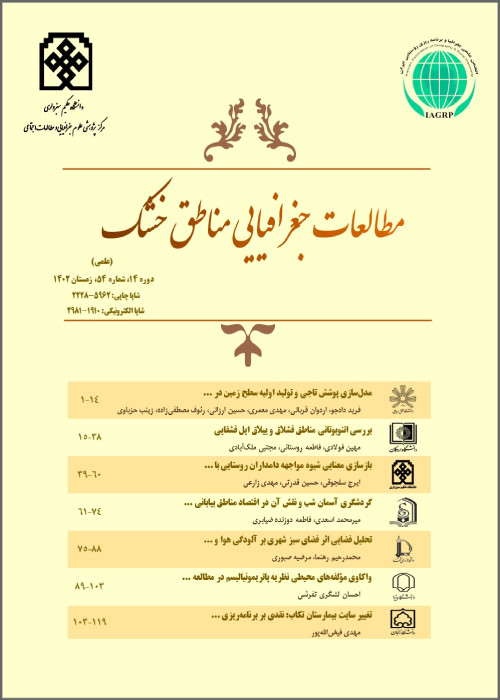Relationship between Atmospheric Water Vapor Transfer and Daily Rainfall in Iran
Because the occurrence of precipitation is directly related to the humidity in the atmosphere or precipitation systems, the study of humidity in the form of precipitable water and the transfer of water vapor is considered in atmospheric studies. Convergence Moisture flux is effective on precipitation, so its effect is much greater in the warmer months, especially in the lower atmosphere, than in the colder months of the year (Darand and Pajhoh, 2019a). Examination of convergence moisture flux in consecutive and inclusive precipitation events in Iran shows that the core of maximum precipitation in the Zagros highlands in southwestern Iran has the most concurrence with the convergence of mid-atmosphere moisture flux (775-700 hPa) (Darand and Pajhoh, 2019b). In some studies, the calculation of moisture flux is used as a tool to identify the phenomena of long and narrow filaments rich in large amounts of moisture called atmospheric river, which has a great impact on heavy rainfall. Esfandiari and Lashkari (2021), by identifying atmospheric rivers and their impact on heavy rainfall in Iran, showed that an average of 11 heavy rainfall per year in the cold season is related to atmospheric rivers. They are on average 20 to 50 percent effective in heavy rainfall each month.
This study received gridded data on precipitation and humidity flux components including specific humidity (q), wind zonal (u), and meridian (v) from the ECMWF database and applied the equation precipitable water (1) and moisture flux (2) and other related equations (3 to 11), which shows the transfer and supply of moisture as bellow: (1) (2) (3) qu (4) qv (5) qu+qv (6) IWV+u925+v925 (7) IWV+u850+v850 (8) IWV+u700+v700 (9) IWV+uv925 (10) IWV+uv850 (11) IWV+uv700 That IWV is Total Water vapor in atmospheric column or precipitable water, IVT: Vertical integral of water vapor transfer or moisture flux. q: Specific humidity in kg / kg, u and v: zonal meridian wind components in m/s, respectively, g: is gravity acceleration and dp: is the pressure difference between two adjacent pressure levels. After calculating the above equations, their relationship and correlation with gridded and surface precipitation in Iran were obtained through the coefficient of determination R2 (12): (12) .
Compared to water vapor transfer (IVT), daily rainfall in Iran is more related to the amount of water vapor (IWV). The most correlation between the amount of water vapor and daily rainfall in Iran is observed in the western and eastern parts of Iran. In contrast, the most correlation between daily rainfall and IVT is observed in the west and southwest of Iran. Among the moisture zonal and meridional flux components, Iran's daily rainfall is most related to its meridional component which probably indicates the transfer of moisture from southern and tropical offerings to Iran. The highest correlation between daily rainfall and meridional moisture flux component is observed in western and southwestern Iran. In the relationship between daily precipitation and moisture transfer components in the lower and middle levels of the atmosphere, it was found that the level of 700 hPa has the highest correlation in the moisture transfer of precipitation in Iran. This relationship is more in the west and southwest of Iran than in other places. From the sum of zonal and meridional wind components and the amount of water vapor at 925 hPa and its relationship with daily rainfall, it was found that unlike the other two levels (700 and 850hpa), the strongest relationship is observed in the east (South Khorasan) and then southwest of Iran. In addition, this relationship is stronger in the East-West section than in other sections. The highest correlation is between seasonal precipitation and moisture flux and the amount of water vapor in winter. The highest correlation is related to the western, southwestern regions with most of Shahrekord and Yasuj (about 55%), and parts of the east (South Khorasan). It can be said that in winter, in terms of quantity and extent, there is a greater relationship between the parameters of moisture transfer and precipitation. And it shows the amount of humidity in winter more than in other seasons. These results can also be seen in relation to winter precipitation and the amount of water vapor.
To investigate the amount of water vapor transfer as a predictor variable for daily rainfall in Iran, The coefficient of determination R2 was used for the relationship between water vapor components and daily precipitation in Iran. According to the results of Ralph et al. (2004), the relationship between moisture flux and precipitation is well seen in all annual maps. The zonal component alone is effective in transferring moisture from some of the rainfall in the southwest of the country (Yasuj and Shahrekord), while the meridional component of wind with specific humidity has a more effective relationship with daily rainfall in Iran. Similar to the results of Karimi and Farajzadeh (2011), Barati et al. (2014), and Darand and Pajooh (2019), the relationship between daily rainfall and moisture components at the levels of 700, 850, and 925 was found that the level of 700 hPa has a stronger relationship than the two another level. The maximum relationship between precipitation and moisture flux is located in southwestern Iran and the effect of zonal and meridional wind components on the moisture flux of this region is significant. The highest correlation between seasonal rainfall in Iran and the amount and transfer of water vapor is related to winter, which is consistent with the results of Lavres and Villarini (2014) in Europe. Finally, it can be said that the use of zonal and meridional moisture flux components can show the variability of precipitation. And be used as an indicator and predictor variable in precipitation in the study of daily precipitation in Iran.
- حق عضویت دریافتی صرف حمایت از نشریات عضو و نگهداری، تکمیل و توسعه مگیران میشود.
- پرداخت حق اشتراک و دانلود مقالات اجازه بازنشر آن در سایر رسانههای چاپی و دیجیتال را به کاربر نمیدهد.



